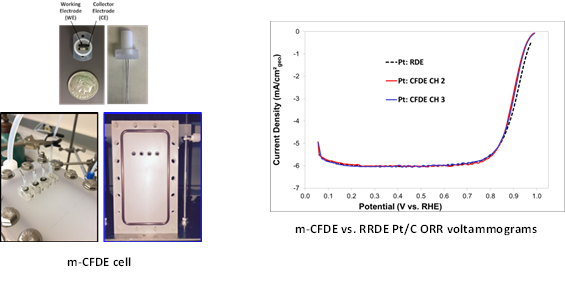| Laboratory: | Argonne National Laboratory |
| Capability Expert: | Debbie Myers |
| Capability Details: | |
| Title: | Combinatorial hydrodynamic screening of catalyst activity, selectivity, and stability |
| Class: | Characterization and Testing |
| Description: | This capability utilizes a multi-electrode channel flow double electrode (m-CFDE) cell and multi-channel potentiostats for combinatorial hydrodynamic screening of PGM-free catalyst activity and selectivity, as well as for detection of electrochemically active catalyst degradation products. The m-CFDE provides information identical to that of the commonly-used rotating ring-disk electrode (RRDE) hydrodynamic technique, but allows the characterization of four catalyst compositions simultaneously. The m-CFDE has four removable double-electrode plugs, each containing a glassy carbon working electrode on which the catalyst is deposited, and a platinum collector electrode for downstream detection of reaction products or catalyst degradation products. The removable electrode plugs are situated in a channel flow cell to allow the flow of reactant-containing liquid electrolyte across the four working and collector electrode pairs simultaneously. The flowing electrolyte eliminates the influence of mass transport limitations on the measured current, thus allowing determination of the kinetic activity of the catalyst samples for the chosen reaction. The m-CFDE has been used for the high-throughput testing of the oxygen reduction reaction (ORR) activity and stability of high surface area platinum and PGM-free electrocatalysts. |
| Capability Bounds: | The limit of catalysts that can be evaluated at one time is four as the m-CFDE is equipped with four slots for the double-electrode plugs. Additional cells or electrode slots can be added in the future as needed. |
| Unique Aspects: | This is a unique cell developed recently by Argonne and is only available at Argonne. A commercial multi-channel double electrode cell does exist, but it does not have removable electrodes and thus is not amenable to high-throughput deposition and screening of catalyst activity. |
| Availability: | This system is not located in a user facility and is fully available for ElectroCat use. |
| Reference: | “High-Throughput Synthesis, ORR Activity Modeling, and Testing of non-PGM PEMFC Cathode Catalysts,” Deborah J. Myers (Primary Contact), Xiaoping Wang, Sheldon Lee, Magali Ferrandon, Nancy N. Kariuki, and Theodore Krause, FY 2015 Progress Report for the Hydrogen and Fuel Cell Technologies Office, U.S. Department of Energy. |
| Benefit: | The use of the m-CFDE can accelerate the development of new fuel cell catalysts by providing a means for screening the catalytic activity, selectivity, and stability of multiple catalysts simultaneously. It provides information identical to that of the commonly used rotating ring-disk electrode hydrodynamic technique, but for multiple catalyst compositions simultaneously. |

